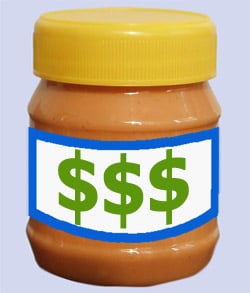 One thing I know about the cost of food is that it is very much a commodity in that prices go up and sometimes prices go down. Two factors: supply / demand and seasonal pricing have a large impact on what you pay to feed your family. This is a commodity market that nearly everyone has to play each week at the grocery store. If you play this market wisely, you can come out further ahead than the average shopper.
One thing I know about the cost of food is that it is very much a commodity in that prices go up and sometimes prices go down. Two factors: supply / demand and seasonal pricing have a large impact on what you pay to feed your family. This is a commodity market that nearly everyone has to play each week at the grocery store. If you play this market wisely, you can come out further ahead than the average shopper.
I talk about shopping by the calendar frequently. Typically, October and November introduce great deals on holiday foods: Stove top stuffing, turkey, instant mashed potatoes, broth, cranberries, marshmallows, ice cream, pie shells, whipped cream, pudding. Kraft heavily discounts their products. Obviously, you’ll get excellent deals on candy before and after Halloween with the right sale/coupon combinations. This is a great time of year to buy baking and candy-making items (choc chips, sprinkles, vanilla, corn syrup, nuts, etc). Finally, look for great deals on crackers, canned soups, and canned vegetables.
Incidentally, outside of grocery shopping, this can also be a good time of year to buy a car (clearing the way for 2012’s models), a house, fishing equipment, crystal, silver, and glassware.
You may have seen last week, however, some unsettling news for fans of peanut butter: the price of peanuts is going up. Way up. Because of a hot, dry summer and competition from more profitable crops like cotton, peanut yields are down. Entire fields of peanuts coming up empty have been reported. For those farmers who burned through large amounts of fuel to keep their crops irrigated, their investment needs to be recouped. According to the USDA, the price of runner peanuts (the most common variety – which is used for peanut butter) has reached nearly $1,200 a ton, compared to under $450 a ton this time last year.
As a result, the J.M. Smucker Co. which makes Jif peanut butter announced it would raise it’s wholesale prices by 30 percent in November. Kraft Foods Co., the makers of Planters peanut butter, is raising prices 40 percent on Oct. 31. In short, you can expect bigger prices and smaller jars very soon.
Looking through our database at SavingsAngel.com, I don’t see any spectacular deals on peanut butter at local stores this week. (September saw savings of 50%-60% off thanks to back to school sales). However, if you are short on peanut butter, I would recommend loading up on enough peanut butter to get you through the winter before the higher prices trickle down to store shelves in the coming weeks.
There have been many other increases in food prices this year. The cost of meat, for example, is 30 to 50 cents a pound higher this year due to higher feed costs and lower production figures. As a result, food manufacturers like ConAgra have risen their prices and shrunk package sizes on their frozen food lines: Healthy Choice and Marie Callender’s.
There is a bright spot in the food market, however. Petroleum prices have recovered a bit and that translates to savings in transportation costs and packaging. Additionally, there have been some market price reductions for a few commodities including wheat and cocoa. This means that you could possibly see some savings on chocolate, bread, and pasta in time for the holidays.
As the shopper for your family, you are investing in the food market each week. I hope my “hot stock tips” will allow you to profit for your family. As is the case in investing, buying low makes sense. When the prices of food are high, hopefully, you’ve built your safety net at home: three to six months of peanut butter, for example, to get you through the spike in prices. Come spring, a new crop should be ready, and the prices should return to normal levels.
Amateur food “investors” may scoff at an increase in price for one product line such as peanut butter – but enlightened shoppers know better. They apply these same principles throughout the year on everything they buy. As a result, the dollar or two price difference on each product means thousands of dollars saved by the end of the year – with just a moderate amount of sweat equity invested.
The easiest way to cut your grocery bill in half is through using manufacturers coupons combined with the best sales at local West Michigan stores. Normally, this takes a lot of work to create a winning shopping list for your family. Each week, SavingsAngel.com combines over 2,000 products on sale at local grocery and drug stores with their enormous database of manufacturer coupons ““ which are found in Sunday’s Grand Rapids Press and throughout the Internet. This combination results in access to over 300 products each week for 50% off or better. Here are a few examples of deals that are available until Saturday at midnight. Please look in Tuesday’s Grand Rapids Press each week for tips on how you can easily start cutting your grocery bill!


